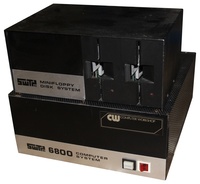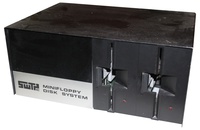|
The SWTPC 6800 Computer System is designed around Motorola’s outstanding 6800 microprocessor chip and its integral family of support devices. The basic system includes the following: 15 1/8” W x 7” H x 15 1/4” D chassis with cover, mother board, memory card with 2048 bytes of 8 bit static RAM memory, serial 20 Ma. TTY teletypewriter/RS-232 terminal interface card, microprocessor card featuring a ROM stored minioperating system, power supply capable of driving the system with a full 16K bytes of memory, assembly instructions, diagnostics and programming manuals.
The 6800 microprocessor chip used in the system is a full specification Motorola component featuring 8 bit parallel data processing, 16 bit — 65K address buss, 72 instructions with seven addressing modes, maskable and non-maskable interrupts, two accumulators, an index register, variable length stack, DMA Capability, 1.1 microsecond cycle time and TTL compatibility.
The Motorola mini-operating system ROM used in the system gives the user complete teletypewriter/terminal control the instant the system is turned on. The ROM used is a standard Motorola part and makes the system program compatible with other Motorola products. The mini-operating system features a tape load/dump routine, a memory and register examine and/or change function and an execute user’s program command.
In addition to the step-by-step assembly instructions included with the kit, there is a documentation package including Motorola’s M6800 Programming Manual plus our own 200 page loose-leaf notebook containing programming information and examples, diagnostic and game programs and an application form to join Motorola’s M6800 User’s Group.
The system has been designed using flexible plug-together construction on solder coated, doubled-sided plated thru hole circuit boards. The system boards are fully buffered with on board voltage regulators for minimum noise and maximum reliability. The processor is fed from a crystal controlled clock which simultaneously generates five independent baud rate clocks for selectable serial interface data rates. Any combination of up to seven optional serial or parallel interface boards may be plugged onto the system to interface the computer with external devices. These inexpensive interface options are also built around Motorola 6800 family chips and are actually programmable within themselves.
Date Introduced 1975
Dimensions 6 3/4 x 15 x 15 3/8 in.
Manufacturer Southwest Technical Products (SWTP)
Speed 980 KHz
Memory Type Semiconductor
Memory Size 4K
Memory Width 8-bit
Cost $395
Our unit together with the twin 5.25" disk drive unit was very kindly donated by David Parr who gave us the following notes for this machine:
The SWTP box is almost fully-populated with cards and RAM as it is an amalgamation of more than one system we used to have at CovUni. It contains a Microspeech speech synthesis card (I left you a copy of the documentation for that), which we used to program to make some Hawking-like pronouncements. It has two sockets on the top edge, one for audio output and the other for inputting sound to merge with the generated speech.
The box also contains a Digisector TV capture card, to which we used to connect the Sony b+w video camera I delivered in the brown suitcase. We could also connect a TV set to monitor what was happening, and the card would display on this a white dot at whatever pixel was being captured at any time. By programming it to capture a vertical row of pixels, a vertical white line would appear and sweep slowly across the TV screen from left to right, taking about 10 seconds in total. Because the card is American, the number of lines on a UK TV screen doesn’t match and so the white line didn’t quite cover the whole screen. A 10 sec scan time was ok for static objects but we used it mainly for Open Days when school children would visit, and they had to sit still for an unnaturally long time to have their pictures taken. In practice they often used to experiment, for instance switching position halfway through to get a front view and a profile in one scan !
The software we were initially supplied with was very simple, in Basic, so I wrote some quite large chunks of assembler code to improve the scanning procedure, perform picture enhancements and print the output in various formats. Initially we only had daisy-wheel printers so I just used the full-stop character to build up shades of grey for each pixel. The largest size I ever printed was about A2 (on fanfold paper) and that took three and a quarter hours ! Later we got dot-matrix printers, which improved things quite a bit. We also tried to broaden the use a bit, analysing images and producing histograms which could be used to distinguish different objects.
The box also contains a parallel card (used for a printer), two serial cards for VDUs, and a connector for a pair of floppy disk drives (we used to have upright 5” drives attached). The memory slots are full too, though I’m not certain how much is fitted – possibly around 32K"
Manufacturer: SWTPC
Date: 1975
Comment on This Page
Magazines RELATED to SWTPC 6800 (2) in our Library
Other Systems Related To SWTPC 6800 (2):
This exhibit has a reference ID of CH43762. Please quote this reference ID in any communication with the Centre for Computing History.
|
|
Click on the Image(s) For Detail
|












